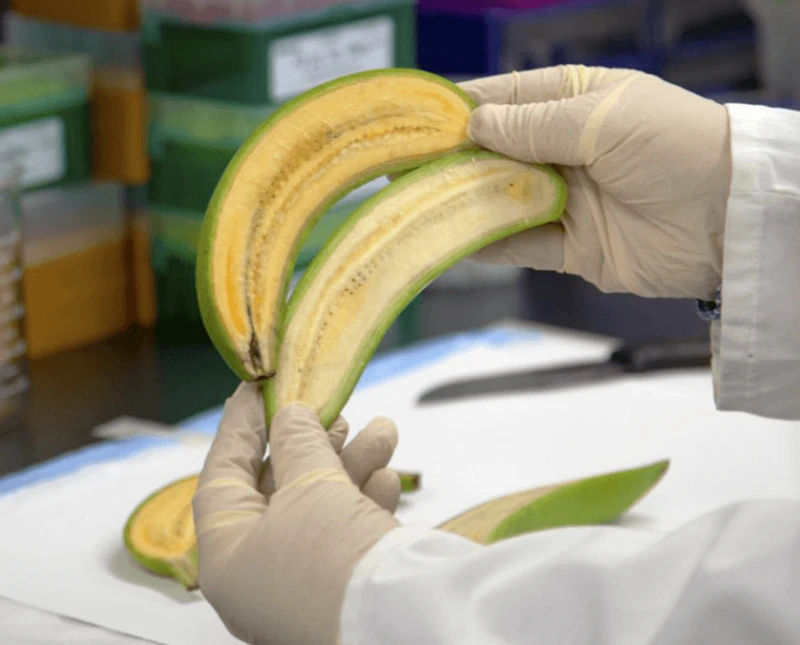Orange ‘super banana’: Gates-funded Ugandan scientists develop vitamin A enhanced fruit that could help reduce blindness and save lives
Orange ‘super banana’: Gates-funded Ugandan scientists develop vitamin A enhanced fruit that could help reduce blindness and save lives

Wilberforce Tushemereirwe holds up a genetically modified banana that took millions of dollars and 20 years to make. It contains so much provitamin A, a substance that transforms into vitamin A in the body, that its flesh has a distinctive orange tint.
This “super banana” was created at Uganda’s National Agricultural Research Laboratories (NARL) for the noblest of causes: to save the lives of thousands of children who die in Uganda every year from vitamin A deficiency. Scientists have long crossbred banana plants to improve resistance to pests, fungus, or drought. But fortifying bananas to deliver nutrients to humans who eat them is a first.
The breakthrough is the result of a partnership of the lab in Kawanda, where Tushemereirwe serves as director, James Dale, an Australian agricultural scientist and banana expert, and the Bill and Melinda Gates Foundation, which invested $11 million in one of the longest running research projects the foundation has ever undertaken.
The Ugandan government has tried for decades to solve the problem—with limited success. Distribution of vitamin A capsules, for example, worked well in urban areas but failed to reach those most in need in rural areas. Fortifying maize and wheat flour and edible oils with vitamin A to boost nutritional values proved more effective. But those foods are not consumed in large enough amounts to make a meaningful difference.
 | Videos | More... |

Video: Nuclear energy will destroy us? Global warming is an existential threat? Chemicals are massacring bees? Donate to the Green Industrial Complex!
 | Bees & Pollinators | More... |

GLP podcast: Science journalism is a mess. Here’s how to fix it

Mosquito massacre: Can we safely tackle malaria with a CRISPR gene drive?

Are we facing an ‘Insect Apocalypse’ caused by ‘intensive, industrial’ farming and agricultural chemicals? The media say yes; Science says ‘no’
 | Infographics | More... |

Infographic: Global regulatory and health research agencies on whether glyphosate causes cancer
 | GMO FAQs | More... |

Why is there controversy over GMO foods but not GMO drugs?

How are GMOs labeled around the world?

How does genetic engineering differ from conventional breeding?
 | GLP Profiles | More... |

Alex Jones: Right-wing conspiracy theorist stokes fear of GMOs, pesticides to sell ‘health supplements’





 Viewpoint — Fact checking MAHA mythmakers: How wellness influencers and RFK, Jr. undermine American science and health
Viewpoint — Fact checking MAHA mythmakers: How wellness influencers and RFK, Jr. undermine American science and health Viewpoint: Video — Big Solar is gobbling up productive agricultural land and hurting farmers yet providing little energy or sustainabilty gains
Viewpoint: Video — Big Solar is gobbling up productive agricultural land and hurting farmers yet providing little energy or sustainabilty gains Fighting deforestation with CO2: Biotechnology breakthrough creates sustainable palm oil alternative for cosmetics
Fighting deforestation with CO2: Biotechnology breakthrough creates sustainable palm oil alternative for cosmetics Trust issues: What happens when therapists use ChatGPT?
Trust issues: What happens when therapists use ChatGPT? California, Washington, Oregon forge immunization alliance to safeguard vaccine access against federal undermining
California, Washington, Oregon forge immunization alliance to safeguard vaccine access against federal undermining 30-year-old tomato line shows genetic resistance to devastating virus
30-year-old tomato line shows genetic resistance to devastating virus The free-range chicken dilemma: Better for birds, but with substantial costs
The free-range chicken dilemma: Better for birds, but with substantial costs ‘You have to treat the brain first’: Rethinking chronic pain with Sanjay Gupta
‘You have to treat the brain first’: Rethinking chronic pain with Sanjay Gupta
